- RN 1 (Huì Yīn, 会阴)
- RN 2 (Qū Gǔ, 曲骨)
- RN 3 (Zhōng Jí, 中极)
- RN 4 (Guān Yuán, 关元)
- RN 5 (Shí Mén, 石门)
- RN 6 (Qì Hǎi, 气海)
- RN 7 (Yīn Jiāo, 阴交)
- RN 8 (Shén Què, 神阙)
- RN 9 (Shuǐ Fēn, 水分)
- RN 10 (Xià Wǎn, 下脘)
- RN 11 (Jiàn Lǐ, 建里)
- RN 12 (Zhōng Wǎn, 中脘)
- RN 13 (Shàng Wǎn, 上脘)
- RN 14 (Jù Què, 巨阙)
- RN 15 (Jiū Wěi, 鸠尾)
- RN 16 (Zhōng Tíng, 中庭)
- RN 17 (Dàn Zhōng, 膻中)
- RN 18 (Yù Táng, 玉堂)
- RN 19 (Zǐ Gōng, 紫宫)
- RN 20 (Huá Gài, 华盖)
- RN 21 (Xuán Jī, 璇玑)
- RN 22 (Tiān Tū, 天突)
- RN 23 (Lián Quán, 廉泉)
- RN 24 (Chéng Jiāng, 承浆)
The ren mai, which runs along the anterior midline of the body, has 24 points. The first is in the perineal region, RN 1 (huì yīn); the last is on the face in the mentolabial sulcus, RN 24 (chéng jiāng). Point indications include brain and nervous, respiratory, digestive, urinary, and reproductive system problems and disorders of the running course.
RN 1 (Huì Yīn, 会阴)
Intersecting point of ren mai, du mai, and chong mai
Location. In the perineal region at the midpoint of a line connecting the anus and the posterior border of the scrotum in males and the posterior commissure of the labium majoris in females (Pic. 3-99).
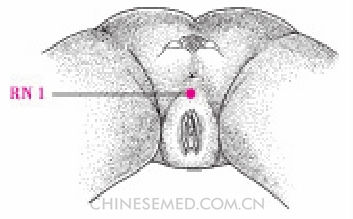
Location.method. With the patient lying on one side or in knee-chest position, the point is midway between the anus and the external genitalia.
Actions. Awaken the mind, open the orifices, and promote urination.
Indications. Pruritus vulvae, vaginal pain, sweating of the private parts, prolapse of rectum, hemorrhoids, other disorders of the anus and external genitalia; irregular menstruation, amenorrhea, other gynecological disorders; nocturnal emission, testitis, scrotitis, other andrological conditions; depression, mania, epilepsy, coma, asphyxia due to drowning.
Manipulation. Acupuncture: Needle perpendicularly 0.5~1.0 cun. Local distention and soreness can pass to the external genitalia and anus. Moxibustion: Use 3~5 cones of non-scarring moxibustion, or use warming needle moxibustion for 20 minutes, or use a moxa stick for 5~10 minutes.
Precautions. Do not needle deeply. Insert between the anal tube and bulb of the urethra in men, the anal tube and the vagina in women. Forward and upward insertion can pierce the bulb of urethra or the urogenital diaphragm through to the prostate gland and cause bleeding and inflammation. Backward and upward insertion can pierce the anterior protruding perineal fexure of the rectum, causing local inflammation. This point is contraindicated in pregnancy.
RN 2 (Qū Gǔ, 曲骨)
Intersecting point of the ren and the foot jueyin channels
Location. On the lower abdomen above the pubic symphysis on the anterior median line (Pic. 3-100).

Actions. Nourish essence and maintain erection, supplement the kidney, promote urination, and regulate menstruation.
Indications. Nocturnal emission, impotence, eczema of the scrotum, other andrological conditions; irregular menstruation, dysmenorrhea, leukorrhea, other gynecological disorders; enuresis, difficult urination.
Manipulation. Acupuncture: Needle perpendicularly 0.5~1.0 cun. Local soreness and distention can pass downward to the external genitalia. Moxibustion: Use 3~5 cones of cone moxibustion, or use warming needle moxibustion for 20 minutes, or use a moxa stick for 5~15 minutes.
Precautions. Patients should be asked to urinate completely to avoid damage to the urinary bladder, which can occur if the point is needled deeply. To prevent bleeding, inflammation, or a urine leak into the abdominal cavity, the needle should not pierce the parietal peritoneum. The point is contraindicated in pregnancy.
RN 3 (Zhōng Jí, 中极)
Front-mu point of the bladder; intersecting point of the three foot yin channels and the ren mai
Location. On the lower abdomen at the anterior median line, 4 cun below the umbilicus (Pic. 3-100).
Actions. Clear damp heat, boost the kidney, regulate menstruation, promote the flow of yang qi, and transform qi.
Indications. Hot pain of the lower abdomen, tubercle below the umbilicus, qi moving upward to the heart, other disorders of the lower abdomen; nocturnal emission, impotence, infertility, other andrological disorders; irregular menstruation, flooding and spotting, vaginal pain and itching, persistent lochia after delivery, retention of the placenta, cramping uterine pain after delivery, morbid leukorrhea, other gynecological conditions; enuresis, difficult urination, retention of urine, other urinary system disorders.
Manipulation. Acupuncture: Needle perpendicularly 0.5~1.0 cun after urination. Local soreness and distention can extend to the external genitalia. Moxibustion: Use 5~7 cones of cone moxibustion, or use warming needle moxibustion for 20 minutes, or use a moxa stick for 10~20 minutes.
Precautions. See RN 2 (qū gǔ). Scarring moxibustion is not advisable.
RN 4 (Guān Yuán, 关元)
Front-mu point of the small intestine, intersecting point of the three foot yin channels and the ren mai
Location. On the lower abdomen at the anterior median line, 3 cun below the umbilicus (Pic. 3-100).
Actions. Reinforce original qi to stop collapse, warm the kidney, supplement yang, regulate menstruation, and arrest vaginal discharge.
Indications. Irregular menstruation, menstrual blockage, leukorrhea, infertility, pruritus of the vaginal orifice, uterine prolapse, retention of the placenta, persistent lochia after delivery, other gynecological disorders; seminal emission, impotence, premature ejaculation, other andrological disorders; red and burning urination, enuresis, frequent urination, other urinary tract disorders; abdominal pain, diarrhea, dysentery, sterility, prolapse of rectum, other intestinal disorders; stroke, collapse, deficiency due to cold and exhaustion, emaciation, other conditions due to deficiency of original qi.
Manipulation. Acupuncture: Needle perpendicularly 0.5~1.0 cun after the patient urinates. Local soreness and pain can radiate to the external genitalia and the perineum. Moxibustion: Use 5~9 cones of cone moxibustion, or use warming needle moxibustion for 20 minutes, or use a moxa stick for 10~20 minutes. Medicinal moxibustion is applicable. For body strengthening, use scarring moxibustion once a year.
Precautions. See RN 2 (qū gǔ). The point is contraindicated in pregnancy.
RN 5 (Shí Mén, 石门)
Front-mu point of the sanjiao
Location. On the lower abdomen at the anterior median line, 2 cun below the umbilicus (Pic. 3-100).
Actions. Fortify the spleen, boost the kidney, reduce damp heat, and promote urination.
1 Cui LM. Acupuncture treatment for sixty-fve cases of patients with urinary retention针刺治疗尿潴留65例. Journal of Emergency Traditional Chinese Medicine. 2010; 19(11): 1971.
Indications. Menstrual blockage, leukorrhea, persistent lochia after delivery, pruritus of the vaginal orifice, other gynecological conditions; seminal emission, impotence, other andrological conditions; pain around the umbilicus, distending stomach pain, diarrhea, undigested food in the stool, dysentery, prolapse of the rectum, other intestinal disorders; hernia, qi rising toward the heart from the lower abdomen; edema and difficult urination; abdominal distention, colicky pain of the lower abdomen, other lower abdominal disorders.
Manipulation. Acupuncture: Needle perpendicularly 0.5~1.0 cun. Local soreness and distention can extend to the external genitals. Moxibustion: Use 5~9 cones of cone moxibustion, or use warming needle moxibustion for 20 minutes, or use a moxa stick for 10~20 minutes. For body strengthening, moxibustion may be performed at the local area until it feels warm and comfortable.
Precautions. Needle slowly to avoid injuring the small intestine; quick or strong lifting and thrusting are prohibited. The point is contraindicated in pregnancy.
RN 6 (Qì Hǎi, 气海)
Location. On the lower abdomen at the anterior median line, 1.5 cun below the umbilicus.
Location.method. With the patient supine, the point is half way between the center of the umbilicus and RN 4 (guān yuán) (Pic. 3-100).
Actions. Supplement qi, fortify the spleen, regulate the lower jiao, and reinforce original qi to consolidate the root.
Indications. Wind-stroke collapse, zang organ qi deficiency, lack of strength, other qi deficiency disorders; irregular menstruation, dysmenorrhea, fooding and spotting, uterine prolapse, abnormal vaginal discharge, persistent lochia, retention of the placenta, infertility, other gynecological disorders; seminal emission, impotence, other andrological conditions; enuresis, strangury, retention of urine, other disorders of the urinary system; pain around the umbilicus, edema, tympanites, abdominal distention, constipation, indigestion, diarrhea, dysentery, other intestinal conditions.
Manipulation. Acupuncture: Needle perpendicularly 0.8~1.2 cun after the patient urinates. Local soreness and distention can be felt. Needle obliquely downward 2.0~3.0 cun, Local soreness and distention can extend to the external genitalia. Moxibustion: Use 5~14 cones of cone moxibustion, or use warming needle moxibustion for 20 minutes, or use a moxa stick for 20~30 minutes. Medicinal moxibustion is advisable. For body strengthening, use scarring moxibustion or indirect moxibustion with 5~14 cones once a year.
Precautions. See RN 4 (guān yuán).
RN 7 (Yīn Jiāo, 阴交)
Intersecting point of ren, chong and foot shaoyin channels
1 Sa R. Clinical observation of 60 middle-aged and elderly female patients with urinary stress incontinence treated with moxibustion at RN 6 (qì hǎi) 温灸气海穴治疗中老年女性应力性尿失禁60例临床观察. China Journal of Traditional Chinese Medicine and Pharmacy. 2008; 23(10): 944.
Location. On the lower abdomen at the anterior median line, 1 cun inferior to the center of the umbilicus (Pic. 3-100).
Actions. Promote urination and reduce edema, regulate menstruation and rectify blood, warm and supplement the lower jiao.
Indications. Irregular menstruation, fooding and spotting, abnormal vaginal discharge, persistent lochia, leukorrhea, other menstrual disorders; abdominal pain, lower abdominal qi ascending to the heart, hernia; edema, difficult urination.
Manipulation. Acupuncture: 1. Needle perpendicularly 0.5~1.0 cun. Local soreness and distention can spread to the umbilicus. 2. Needle obliquely downward 2.0~3.0 cun. The needling sensation can extend to the external genitalia. This technique is mainly for gynecological disorders. Moxibustion: Use 3~5 cones of cone moxibustion, or use warming needle moxibustion for 20 minutes, or use a moxa stick for 10~20 minutes.
Precautions. See RN 4 (guān yuán).
RN 8 (Shén Què, 神阙)
Location. On the upper abdomen in the center of the umbilicus (Pic. 3-100).
Actions. Warm yang to save from collapse, promote urination, and reduce edema.
Indications. Collapse, reversal of counterflow, cold limbs due to deficiency, flaccid stroke; abdominal pain and distention, diarrhea, dysentery, constipation, prolapse of rectum, other intestinal disorders, edema, difficult urination.
Manipulation. Acupuncture: Needling is contraindicated at this point. Moxibustion: Use 5~15 cones of cone, ginger, or salt moxibustion, or use a moxa stick for 20~30 minutes. For body strengthening, moxa the local area until it feels warm and comfortable.
Precautions. Needling is contraindicated.
RN 9 (Shuǐ Fēn, 水分)
Location. On the upper abdomen at the anterior median line, 1 cun above the umbilicus (Pic. 3-101).
Location.method. With the patient supine, the point is at the intersection of the upper 7/8 and lower 1/8 of a line between the xiphisternal synchondrosis and the center of the umbilicus.
Actions. Promote urination, reduce edema, fortify the spleen, and harmonize the stomach.
1 Zhang HY, Lu SF, Xiao N. Effect of warming moxibustion on Shenque acupoint for the treatment of acute diarrhea in children with infantile cerebral palsy. Chin J Integr Med. 2009 Dec; 15(6): 454-7.
Indications. Edema, difficult urination, other water transportation disorders; abdominal distention and pain, borborygmus, diarrhea, other intestinal disorders.
Manipulation. Acupuncture: Needle perpendicularly 0.5~1.0 cun. Moxibustion: Use 7~9 cones of cone moxibustion, or use warming needle moxibustion for 20 minutes, or use a moxa stick for 15~20 minutes.
Precautions. Do not pierce the parietal peritoneum.
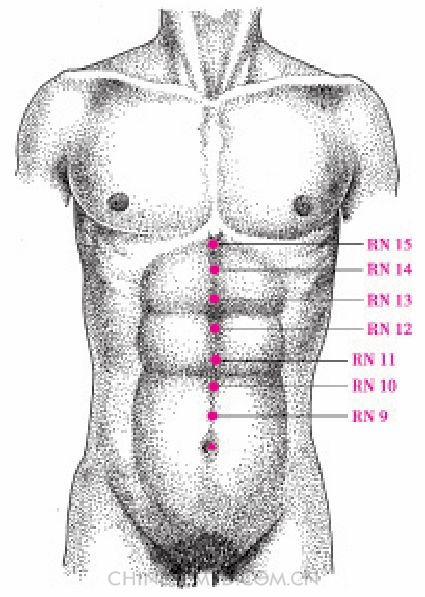
RN 10 (Xià Wǎn, 下脘)
Intersecting point of the ren mai and foot taiyin spleen channels
Location. On the upper abdomen at the anterior median line, 2 cun above the umbilicus (Pic. 3-101).
Location.method. With the patient supine, the point is at the intersection of the upper 3/4 and lower 1/4 of a line between the xiphisternal synchondrosis and RN 8 (shén què).
Actions. Harmonize the stomach, fortify the spleen, and resolve accumulation and stagnation.
Indications. Abdominal pain, abdominal distention, vomiting, hiccup, diarrhea, indigestion, diarrhea, other spleen and stomach disorders; abdominal masses.
Manipulation. Acupuncture: Needle perpendicularly 0.5~1.0 cun. Local soreness and distention can be felt. Moxibustion: Use 7~9 cones of cone moxibustion, or use warming needle moxibustion for 20 minutes, or use a moxa stick for 15~20 minutes.
Precautions. If the needle penetrates the abdominal cavity, it can puncture the omentum majus and the small intestine. In tall and thin patients, the lowest part of the stomach can be level with the iliac crest. Deep needling might penetrate the stomach wall; do not pierce the parietal peritoneum. Insert the needle slowly and withdraw it gently.
RN 11 (Jiàn Lǐ, 建里)
Location. On the upper abdomen at the anterior median line, 3 cun above the umbilicus (Pic. 3-101).
Actions. Harmonize the stomach and fortify the spleen, direct counterflowing qi downward, and promote urination.
Indications. Stomach pain, vomiting, poor appetite, abdominal distention, other spleen and stomach disorders; edema.
Manipulation. Acupuncture: Needle perpendicularly 0.5~1.0 cun. Local soreness and distention can be felt. Moxibustion: Use 3~5 cones of cone moxibustion, or use warming needle moxibustion for 20 minutes, or use a moxa stick for 5~15 minutes.
Precautions. See RN 10 (xià wǎn).
RN 12 (Zhōng Wǎn, 中脘)
Front-mu point of the stomach; influential point of the fu organs; intersecting point of the hand taiyang, hand shaoyang, foot yangming channels and ren mai
Location. On the upper abdomen at the anterior median line, 4 cun above the umbilicus (Pic. 3-101).
Location.method. The point is half way between the xiphisternal junction and the center of the umbilicus.
Actions. Harmonize the stomach, fortify the spleen, warm the middle jiao, and resolve dampness.
Indications. Abdominal pain, stomach pain, acid reflux, abdominal distention, vomiting, diarrhea, hiccups, infantile malnutrition with accumulation, other spleen and stomach disorders; visceral agitation, depression and mania, corpse-like syncope, sunstroke; other disorders of the mind; ceaseless panting, pernicious vomiting due to pregnancy.
Manipulation. Acupuncture: 1. Needle perpendicularly 0.5~1.0 cun. Local soreness, distention, and heaviness can be felt, as can stomach contractions. To protect the pancreas and the abdominal aorta, do not pierce the posterior wall of the stomach. 2. Needle obliquely downward toward the left or right. Moxibustion: Use 5~9 cones of cone moxibustion,or use warming needle moxibustion for 20 minutes, or use a moxa stick for 10~20 minutes. Medicinal moxibustion may be used. For body strengthening and health, use scarring moxibustion once a year.
Precautions. Do not needle too deeply. If the needle penetrates the abdominal cavity, an empty sensation can be felt; if it penetrates the stomach wall, a soft obstruction will be felt, and the patient will feel heat and pain rising to the chest, pharynx, and the hypochondrium. If this occurs, the practitioner must withdraw the needle in order to avoid piercing the stomach wall, pancreas, or aorta. Special care must be taken in thin patients. In patients with hepatosplenomegaly, do not needle upward toward the left or right. If the needle penetrates the parietal peritoneum, it can puncture the transverse colon or the stomach.
RN 13 (Shàng Wǎn, 上脘)
Intersecting point of the hand taiyang and foot yangming channels, and ren mai
Location. On the upper abdomen at the anterior median line, 5 cun above the umbilicus (Pic. 3-101).
Action. Direct counterflowing qi downward to harmonize the stomach, widen the chest, and calm the spirit.
Indications. Abdominal distention, stomach pain, vomiting, acid refux, hiccups, poor appetite, other spleen and stomach disorders; depression, mania; epilepsy.
Manipulation. Acupuncture: 1. Needle perpendicularly 0.5~1.0 cun. Local soreness and distention can radiate to the upper abdomen. 2. Needle upward at a slightly oblique angle for upper jiao disorders. 3. Needle obliquely and slightly downward to reverse counterflowing qi and stop vomiting. Moxibustion: Use 5~7 cones of cone moxibustion, or use warming needle moxibustion for 20 minutes, or use a moxa stick for 10~20 minutes.
Precautions. The point is near the anteroinferior border of the liver. Needling deeply toward the posterior and upward can damage the liver parenchyma and cause bleeding. Deep perpendicular needling can puncture the stomach. Check the size of the liver before needling. If the border of the liver is at this point or above, needling is prohibited. If the border of the liver is not at this point, do not injure the liver or spleen by needling obliquely to the left or right. Do not puncture the parietal peritoneum.
RN 14 (Jù Què, 巨阙)
Front-mu point of the heart
Location. On the upper abdomen at the anterior median line, 6 cun above the umbilicus (Pic. 3-101).
Actions. Dissolve phlegm and calm the spirit, rectify qi and harmonize the stomach.
Indications. Cardiac pain, chest pain, chest fullness, shortness of breath, cough with counterflowing qi, other heart and chest disorders; palpitations due to fright, vexation, amnesia, corpse-like syncope, depression, mania, other conditions of the mind; epilepsy; vomiting, hiccup, cardiac spasm, stomach pain.
Manipulation. Acupuncture: 1. Needle obliquely downward 0.5~1.0 cun. Local soreness and distention can spread downward or upward. 2. For ptosis of the stomach, needle transversely downward 4.0~5.0 cun to penetrate KI 16 (huāng shù) on the left; pull the needle slowly upward and twirl it until the patient feels abdominal distention and contractions. Moxibustion: Use 5~7 cones of cone moxibustion, or use warming needle moxibustion for 20 minutes, or use a moxa stick for 10~20 minutes.
Precautions. Deep perpendicular or obliquely upward needling can damage the liver, stomach, and other organs.
1 Luo YH, Zhong GW, Zhao SP, Tang HM, Zhang LN. efficacy observation of electroacupuncture intervention on severe acute pancreatitis at early stage complicated with intestinal paralysis应用电针干预重症早期急性胰腺炎并发肠麻痹. Chinese Acupuncture & Moxibustion. 2011; 31(2): 105-9.
RN 15 (Jiū Wěi, 鸠尾)
Luo-connecting point
Location. On the upper abdomen at the anterior median line, 1 cun inferior to the xiphisternal junction (Pic. 3-101).
Actions. Relieve the chest and relax the diaphragm, and calm the mind.
Indications. Chest pain, cough, sore throat, palpitations, other chest and lung disorders; epilepsy; mania, depression, other conditions of the mind.
Manipulation. Acupuncture: Needle obliquely downward 0.5~1.0 cun. Local soreness and distention can be felt. Moxibustion: Use 3~5 cones of cone moxibustion, or use a moxa stick for 10~20 minutes.
Precautions. The point is above the liver and below the heart. Deep or oblique upward or downward needling can injure the liver or heart and cause bleeding. Patients should lift their arms during insertion.
RN 16 (Zhōng Tíng, 中庭)
Location. In the anterior thorax on the anterior median line at the midpoint of the xiphisternal junction (Pic. 3-102).
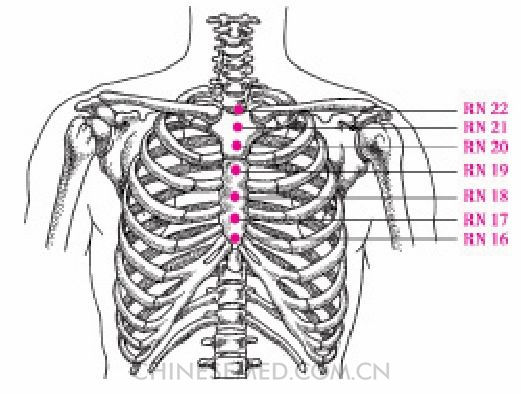
Actions. Relieve the chest and rectify qi, direct counterflowing qi downward to arrest vomiting.
Indications. Chest distress, chest pain; distention and fullness of the chest and abdomen, cardiac spasms, vomiting, other disorders of ascending stomach qi; plum-stone qi.
Manipulation. Acupuncture: Needle transversely 0.3~0.5 cun. Local soreness and distention can be felt. Moxibustion: Use 3~5 cones of cone moxibustion, or use a moxa stick for 5~10 minutes.
RN 17 (Dàn Zhōng, 膻中)
Front-mu point of the pericardium; influential point of qi
Location. In the anterior thorax on the anterior median line and level with the fourth intercostal space (Pic. 3-102).
Location.method. With the patient supine, the point is at the intersection of the mid sternal line and a line connecting the nipples in men, the middle sternal line and level with the fourth intercostal space in women.
Actions. Rectify qi and relieve the chest, and alleviate cough and panting.
Indications. Chest distress, shortness of breath, cough, asthma, chest pain, hiccup, other qi movement disorders; palpitations, arrhythmia, angina pectoris, other heart conditions; Insufficient lactation after delivery, acute mastitis, breast lumps, other mammary disorders.
Manipulation. Acupuncture: Needle transversely or obliquely 0.3~0.5 cun. When the needle arrives at the periosteum, lift, thrust, and twirl it. Local soreness and distention can spread to the anterior chest. Moxibustion: Use 5~9 cones of cone moxibustion, or use a moxa stick for 10~20 minutes. Medicinal moxibustion is applicable. For body strengthening and health, moxa until the skin reddens.
Precautions. Perpendicular needling is prohibited.
RN 18 (Yù Táng, 玉堂)
Location. In the anterior thorax on the anterior median line (Pic. 3-102).
Location.method. The point is 1 cun above RN 17 (dàn zhōng), level with the third intercostal space.
Actions. Relieve cough and panting, rectify qi, relieve the chest, quicken collaterals, and relieve pain.
Indications. Cough, shortness of breath, asthma, vomiting, chest pain, breast swelling and pain, other qi movement disorders.
1 Zhao SL, Yu DR, Lin FL. Bradycardia treated with moxibustion at RN 17 (dàn zhōng) 单灸膻中穴治疗心动过缓. Chinese Acupuncture & Moxibustion. 2010; 30(2): 169.
Manipulation. Acupuncture: Needle transversely 0.3~0.5 cun. Local heaviness and distention can be felt. Needle transversely downward to relieve cough and panting and direct counterflowing qi downward. Needle transversely upward for throat disorders. Needle transversely toward the breast to resolve abscesses and relieve pain. Moxibustion: Use 3~5 cones of cone moxibustion, or use a moxa stick for 5~10 minutes.
RN 19 (Zǐ Gōng, 紫宫)
Location. In the anterior thorax on the anterior median line (Pic. 3-102).
Location.method. The point is 2 cun above RN 17 (dàn zhōng) and level with the second intercostal space.
Actions. Rectify qi, relieve panting and cough, and dissolve phlegm.
Indications. Cough, asthma, fullness in the chest and ribs, chest pain, vomiting, inability to swallow or digest, spitting of blood.
Manipulation. Acupuncture: Needle transversely 0.3~0.5 cun. Local heaviness and distention can be felt. Needle transversely downward for cough and panting, transversely upward for sore throat. Moxibustion: Use 3~5 cones of cone moxibustion, or use a moxa stick for 5~10 minutes.
RN 20 (Huá Gài, 华盖)
Location. In the anterior thorax on the anterior median line, level with the first intercostal space and 1 cun below RN 21 (xuán jī) (Pic. 3-102).
Actions. Relieve cough and panting, relieve sore throat and pain.
Indications. Cough, asthma, chest and rib fullness, chest pain.
Manipulation. Acupuncture: Needle transversely 0.3~0.5 cun. Local soreness and distention can be felt. Moxibustion: Use 3~5 cones of cone moxibustion, or use a moxa stick for 5~10 minutes.
RN 21 (Xuán Jī, 璇玑)
Location. In the anterior thorax on the anterior median line, 1 cun inferior to the suprasternal fossa (Pic. 3-102).
Actions. Relieve the chest and rectify qi, relieve cough and panting.
Indications. Cough, asthma, chest and rib fullness, chest pain; sore throat.
Manipulation. Acupuncture: Needle transversely 0.3~0.5 cun. Local heaviness and distention can be felt. Moxibustion: Use 3~5 cones of cone moxibustion, or use a moxa stick for 5~10 minutes.
RN 22 (Tiān Tū, 天突)
Intersecting point of the ren mai and yinwei mai
Location. On the anterior neck in the center of the suprasternal fossa at the anterior median line (Pic. 3-102).
Location.method. The point is in the depression at the midpoint of the clavicles.
Actions. Diffuse the lung and relieve panting, clear the voice and relieve cough.
Indications. Cough, asthma, chest pain, sputum containing pus and blood, sore throat, sudden aphonia, other lung disorders; goiter, plum-stone qi.
Manipulation. Acupuncture: Needle perpendicularly 0.2~0.3 cun, then angle the needle downward and 0.5~1.0 cun along the posterior border of the manubrium. Local soreness and distention can be felt, and the throat will feel tight and blocked. The sensation will disappear after the needle is withdrawn. Moxibustion: Use 3~5 cones of cone moxibustion, or use a moxa stick for 5~15 minutes.
Precautions. 1. Bloodletting at this point is prohibited. Direct the needle internally along the posterior border of the manubrium, not too deeply and without lifting, thrusting, or twirling. 2. Do not needle the pleura and lungs to avoid causing a pneumothorax. Keep the needle at the midline, and do not needle obliquely toward the left or right. 3. Do not puncture the trachea; after arriving at the muscular layer, do not needle perpendicularly. If the needle injures the wall of the trachea, it can cause cough and bloody sputum.
RN 23 (Lián Quán, 廉泉)
Intersecting point of the renmai and yinwei mai
Location. In the anterior region of the neck on the anterior median line and above the superior border of the thyroid cartilage in the depression superior to the hyoid bone (Pic. 3-103).
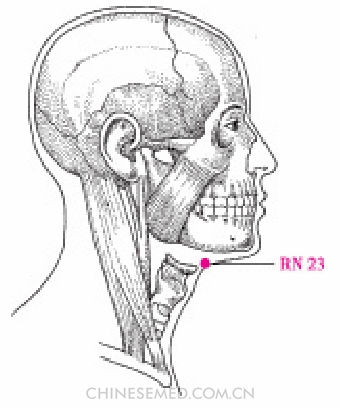
Location.method. With the patient sitting and the head slightly extended, the hyoid tubercle can be palpated between the mandible and the thyroid cartilage.
Actions. Relieve sore throat, increase body fluids, and relieve stuffy orifices.
Indications. Aphasia with a stiff, swollen and painful tongue, increased salivation, oral ulcer, difficulty swallowing, sudden aphonia, throat inflammation, other throat, mouth and tongue disorders.
Manipulation. Acupuncture: 1. Needle obliquely or perpendicularly 0.5~0.8 cun toward the root of the tongue. 2. Lift the needle to the subcutaneous level after insertion and needle obliquely toward the left or right; the root of tongue and the throat will feel tight. Moxibustion: Use a moxa stick for 10~20 minutes.
Precautions. It is not advisable to retain the needle for a long time; the needle might break due to swallowing. Cone moxibustion is prohibited.
RN 24 (Chéng Jiāng, 承浆)
Intersecting point of the ren mai, du mai, hand and foot yangming channels
Location. On the face in the depression in the center of the mentolabial sulcus (Pic. 3-104).
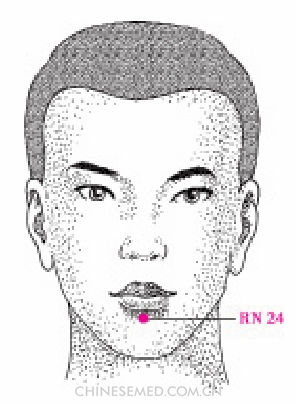
Actions. Dispel wind and unblock collaterals, tranquilize the mind and relieve consumptive thirst.
Indications. Deviated mouth, tight lips, toothache, swelling of cheek and gums, profuse salivation, sudden aphonia; depression, mania; epilepsy.
Manipulation. Acupuncture: Needle obliquely 0.3~0.5 cun. Local soreness and distention can radiate to the mouth and lips. Moxibustion: Use a moxa stick for 5~10 minutes.

